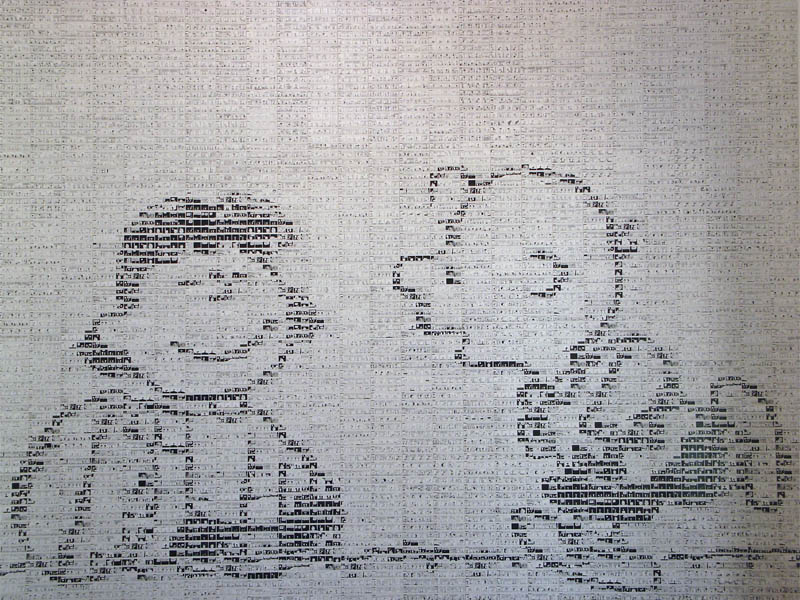Yoenis Cespedes fascinates me. He came to the USA from Cuba last year with no professional baseball experience, and went straight to the majors. He had to adjust to the new level of play, of course. All players do. But usually the kind of learning a player does in the majors is subtle, since the difference between AAA and the majors is subtle. It’s hard for a layman like me to catch on to those subtleties.
But with Cespedes, the learning wasn’t subtle, it was obvious. He’s amazingly talented, and you could see, often from pitch to pitch, the adjustments he was making. The first time he faced a pitcher last year, he had a tendency to swing at breaking pitches out of the strike zone. Once. Maybe twice. But the next time, he’d take the pitch. Then the pitcher would have to throw some new wrinkle at him. Which he’d fail at initially, and then figure that out the next time, too. Then the pitchers have to come in and throw him a strike, and he’d hit it, hard.
Which makes me especially intrigued about this year, his second time through the league. How will the league try to get Yoenis Cespedes out now that he’s seen most of the pitchers before?
So I’d thought I’d look at what Seattle has done in the first two games against him, courtesy of some Pitch F/X graphs from Brooks Baseball.
Game 1
Facing Felix Hernandez. Last year, Cespedes was 4-for-12 against him, with a double and four strikeouts.
Plate appearance #1: Hernandez throws a get-me-over fastball on the first pitch. Cespedes takes. Then Hernandez throws a curve down and away, which Cespedes chases out of the zone, and grounds to third. I’m sure the Mariners wouldn’t mind seeing Cespedes swing at curveballs out of the zone all the time. If this were one year ago, they’d keep throwing it over and over again hoping he’ll still chase it, but as we’ll see, the Mariners don’t just do one thing against him anymore.
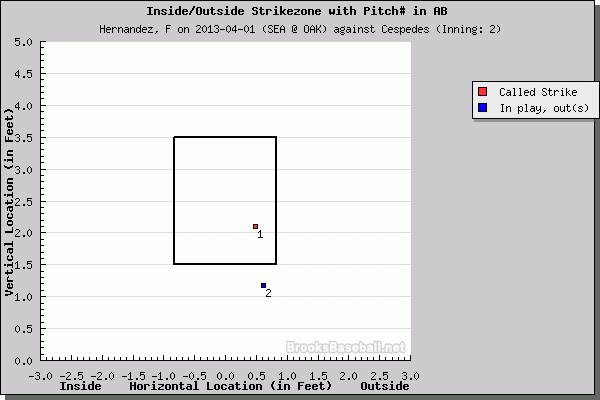 Pitcher F. Hernandez Batter Y. Cespedes
Speed Pitch Result
1 91 Fastball (Four-seam) Called Strike
2 80 Curveball In play, out(s)
Yoenis Cespedes grounds out, third baseman Kyle Seager to first baseman Justin Smoak.
Pitcher F. Hernandez Batter Y. Cespedes
Speed Pitch Result
1 91 Fastball (Four-seam) Called Strike
2 80 Curveball In play, out(s)
Yoenis Cespedes grounds out, third baseman Kyle Seager to first baseman Justin Smoak.
Plate appearance #2: Hernandez throws a slider up and over the middle of the plate on the first pitch. That’s a dangerous pitch to throw Cespedes, and he whacks it, but Brendan Ryan manages to make a good play on it and throw him out. The Mariners win this battle, but you wouldn’t want to use that pitch as an example of how you want to get Cespedes out. We’ll find that out in game 2.
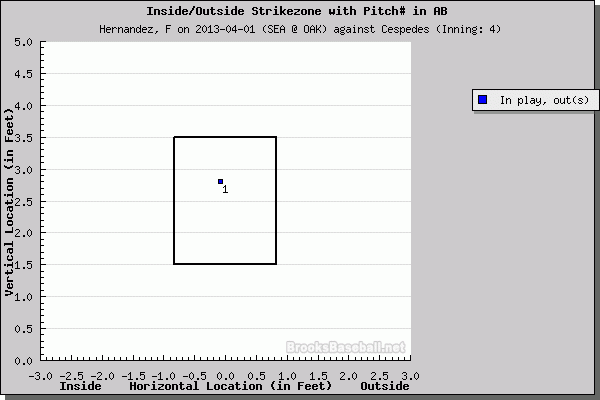 Pitcher F. Hernandez Batter Y. Cespedes
Speed Pitch Result
1 84 Slider In play, out(s)
Yoenis Cespedes grounds out, shortstop Brendan Ryan to first baseman Justin Smoak.
Pitcher F. Hernandez Batter Y. Cespedes
Speed Pitch Result
1 84 Slider In play, out(s)
Yoenis Cespedes grounds out, shortstop Brendan Ryan to first baseman Justin Smoak.
Plate appearance #3: Cespedes hasn’t seen a changeup yet, but Hernandez throws him four of them in this at-bat. Also interesting is how Hernandez moves around the strike zone. Up and in, down and away, up and in, down and in, up and away, up and…oops over the plate. The last pitch is a changeup that’s up and over the plate, slightly in. Again Cespedes jumps on it, and again hits it hard right at a fielder, this time, the third baseman. Cespedes works the at-bat and gets a good pitch to hit, again it finds a glove, but again, this isn’t a recipe you probably want to rely on to get Cespedes out.
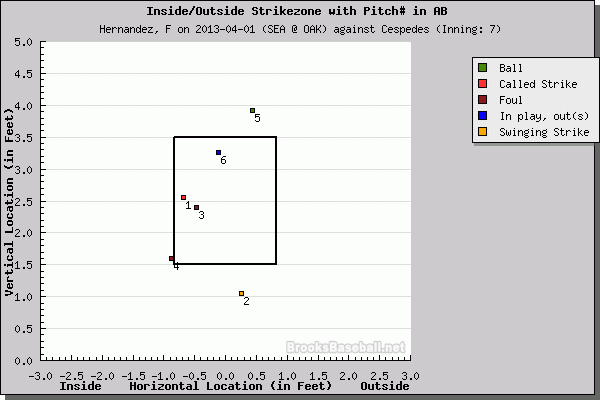 Pitcher F. Hernandez Batter Y. Cespedes
Speed Pitch Result
1 89 Changeup Called Strike
2 87 Changeup Swinging Strike
3 91 Fastball (Four-seam) Foul
4 87 Changeup Foul
5 91 Sinker Ball
6 87 Changeup In play, out(s)
Yoenis Cespedes grounds out, third baseman Kyle Seager to first baseman Justin Smoak.
Pitcher F. Hernandez Batter Y. Cespedes
Speed Pitch Result
1 89 Changeup Called Strike
2 87 Changeup Swinging Strike
3 91 Fastball (Four-seam) Foul
4 87 Changeup Foul
5 91 Sinker Ball
6 87 Changeup In play, out(s)
Yoenis Cespedes grounds out, third baseman Kyle Seager to first baseman Justin Smoak.
Plate appearance #4: This was in the bottom of the ninth, and Felix Hernandez had been replaced by Tom Wilhelmsen. Cespedes had struggled against Wilhelmsen last year, going 0-for-5 with 4 strikeouts. Cespedes gets ahead in the count by laying off a first-pitch curveball off the plate. Wilhelmsen then comes in with a fastball which turns out to be the best pitch of the at-bat for Cespedes to hit, but he fouled it off. Cespedes then lays off another curveball out of the zone. Cespedes is probably looking for another fastball like the 2nd pitch and does get it. But Wilhelmsen throws it inside off the plate, not a good pitch to hit, and Cespedes jams himself and grounds out to third. Another lesson for Cespedes to learn from–it will be fascinating to see what Cespedes and Wilhelmsen do the next time Cespedes faces him ahead in the count 2-1, 3-1, or 3-2.
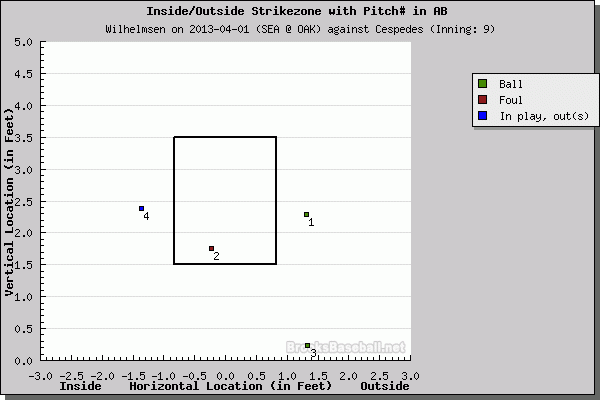 Pitcher T. Wilhelmsen Batter Y. Cespedes
Speed Pitch Result
1 77 Curveball Ball
2 95 Fastball (Four-seam) Foul
3 79 Curveball Ball
4 97 Fastball (Two-seam) In play, out(s)
Yoenis Cespedes grounds out, third baseman Kyle Seager to first baseman Justin Smoak.
Pitcher T. Wilhelmsen Batter Y. Cespedes
Speed Pitch Result
1 77 Curveball Ball
2 95 Fastball (Four-seam) Foul
3 79 Curveball Ball
4 97 Fastball (Two-seam) In play, out(s)
Yoenis Cespedes grounds out, third baseman Kyle Seager to first baseman Justin Smoak.
Game 2
Facing Hisashi Iwakuma. Last year, Cespedes was 2-for-4 against him, with a homer.
Plate appearance #1: The pitchers Cespedes faces in this game don’t have the kind of stuff that Hernandez and Wilhelmsen had yesterday. Cespedes hardly sees any inside pitches in this game. We can see what Iwakuma wants to do in this game: instead of working inside and outside like the fireballers yesterday, he lives on the outside corner against him, either slightly over the plate away, or slightly off the plate away. Iwakuma misses away on the first two pitches, and Cespedes takes the third to make him throw a strike. Then Iwakuma makes the same mistake Hernandez did yesterday, leaving a slider up and over the plate. This time, Cespedes doesn’t hit it at any fielders, as he deposits it over the center field fence for a home run.
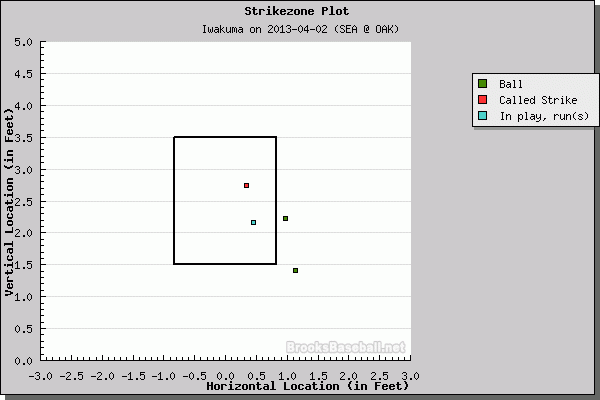 Pitcher H. Iwakuma Batter Y. Cespedes
Speed Pitch Result
1 89 Fastball (Four-seam) Ball
2 81 Slider Ball
3 89 Fastball (Four-seam) Called Strike
4 81 Slider In play, run(s)
Yoenis Cespedes homers (1) on a line drive to center field.
Pitcher H. Iwakuma Batter Y. Cespedes
Speed Pitch Result
1 89 Fastball (Four-seam) Ball
2 81 Slider Ball
3 89 Fastball (Four-seam) Called Strike
4 81 Slider In play, run(s)
Yoenis Cespedes homers (1) on a line drive to center field.
Plate appearance #2: Iwakuma avoids throwing Cespedes any sliders after that. He throws a fastball inside for show on the first pitch, and then goes back to the outside corner. He leads off with a good curveball down and away, and then goes up the ladder with two excellently located fastballs, both of which Cespedes swings through. I’m guessing the second fastball in a row surprised Cespedes a bit.
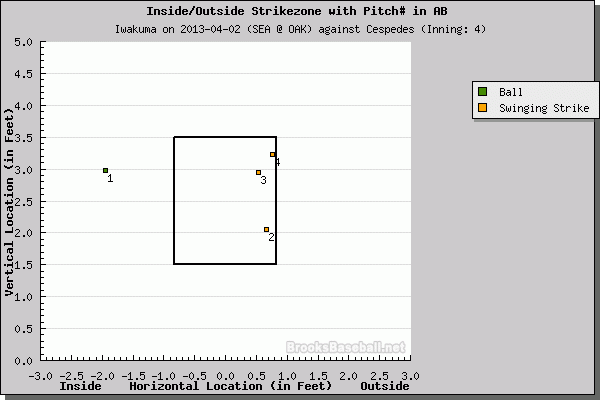 Pitcher H. Iwakuma Batter Y. Cespedes
Speed Pitch Result
1 89 Sinker Ball
2 73 Curveball Swinging Strike
3 92 Fastball (Four-seam) Swinging Strike
4 91 Fastball (Four-seam) Swinging Strike
Yoenis Cespedes strikes out swinging.
Pitcher H. Iwakuma Batter Y. Cespedes
Speed Pitch Result
1 89 Sinker Ball
2 73 Curveball Swinging Strike
3 92 Fastball (Four-seam) Swinging Strike
4 91 Fastball (Four-seam) Swinging Strike
Yoenis Cespedes strikes out swinging.
Plate appearance #3: Iwakuma is gone, and Cespedes is now facing Carter Capps, whom he faced once last year. He takes a first pitch curveball over the inside of the plate. Then Capps gets him to chase a couple of curveballs just off the plate, and strikes him out. Next time they face each other, I’ll be watching to see if Cespedes chases those curveballs again, or if he lays off the next time, and makes him throw something in the zone he can hit.
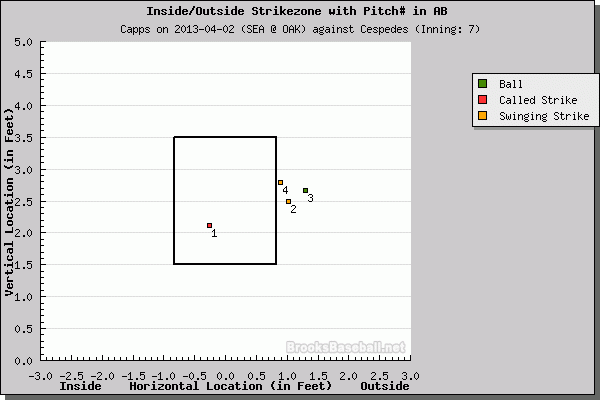 Pitcher C. Capps Batter Y. Cespedes
Speed Pitch Result
1 83 Curveball Called Strike
2 85 Curveball Swinging Strike
3 96 Fastball (Four-seam) Ball
4 82 Curveball Swinging Strike
Yoenis Cespedes strikes out swinging.
Pitcher C. Capps Batter Y. Cespedes
Speed Pitch Result
1 83 Curveball Called Strike
2 85 Curveball Swinging Strike
3 96 Fastball (Four-seam) Ball
4 82 Curveball Swinging Strike
Yoenis Cespedes strikes out swinging.
Plate appearance #4: Oliver Perez, this time, who like Capps had faced Cespedes only once before. He takes the first pitch for a strike, as he often does. Then on the second pitch, he gets a slider it a hittable location over the middle of the plate, but fouls it off. Then he swings through a well-located fastball low and away in the zone.
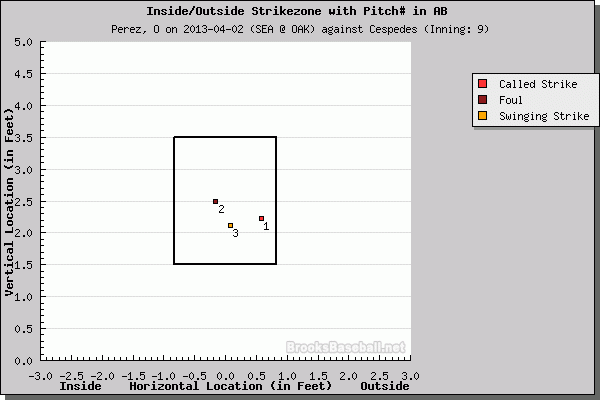 Pitcher O. Perez Batter Y. Cespedes
Speed Pitch Result
1 88 Sinker Called Strike
2 80 Slider Foul
3 92 Sinker Swinging Strike
Yoenis Cespedes strikes out swinging.
Pitcher O. Perez Batter Y. Cespedes
Speed Pitch Result
1 88 Sinker Called Strike
2 80 Slider Foul
3 92 Sinker Swinging Strike
Yoenis Cespedes strikes out swinging.
Eight at-bats isn’t enough to draw any definite conclusions from, but it’s enough to speculate a bit. Here’s a rough-draft preliminary formula I’d draw from this:
- If you have a pitcher that Cespedes hasn’t seen much, try to throw him breaking pitches off the plate and get him to chase. That won’t work forever, though.
- He can hit fastballs and crushes badly located off-speed stuff. So if he has faced a pitcher multiple times, mix up your pitches and avoid predictability.
- If your pitcher has good velocity, you can try to jam him inside. Don’t try this with soft-tossers, though.
- Location, location, location.
I don’t know that there’s anything there that isn’t true of most hitters in general, except that Cespedes doesn’t seem to have any one particular hole in his swing or vulnerability in his approach except against unfamiliar pitchers. So you have to try to fool him like Iwakuma did when he went up the ladder on him, or just hope that when you miss your spot that it finds a fielder.
Now go turn on the A’s game and watch Joe Saunders blow my whole rough theory apart tonight by pounding Cespedes inside with loopy sliders or something. That would be cool, because baseball is awesome like that, and there are always new lessons to be learned.









